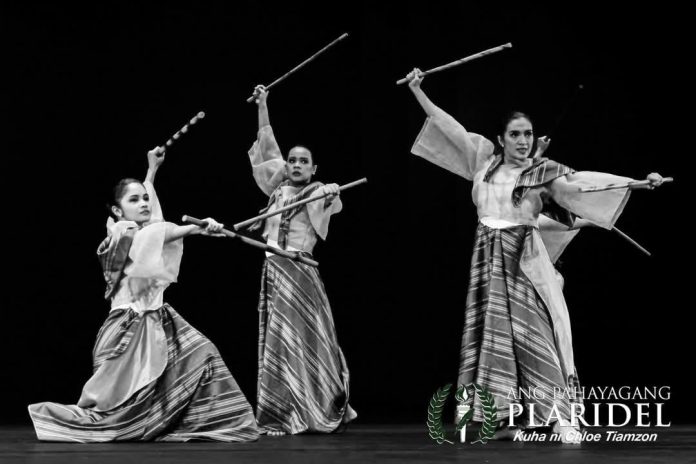The performance of the eskrimadoras, or female arnis players, seemed to be a tribute to brave Filipina warriors during the 2025 PASINAYA Open House Festival of the Cultural Center of the Philippines (CCP).
Female members of the Bayanihan Philippine National Folk Dance Company, including actress Ina Feleo, transformed to fierce eskrimadoras wearing baro’t saya combining arnis movements with graceful choreography.
Arnis, kali or eskrima are interchangeable terms referring to traditional martial arts of the Philippines which emphasize weapon-based fighting with a Yantok (fighting stick), Baraw (knife), Bolo (machete), Bankaw (staff), and various improvised weapons, as well as “open hand” techniques without weapons.
Arnis comes from arnes de mano, Spanish for “harness of the hand,” or “armor of the hand,” used to describe the way colonizers observed Filipinos resist and fight back with empty-handed combat.
Kali has its origin in Cebuano, “Ka” stands for camot “hand”, and “Li” for lehok “movement”. As a whole, Kali can be translated into “movement of the hand”.
Eskrima is derived from the Spanish word ” Esgrima “describing a brief fight or fencing”.
The art of hand-to-hand combat has always been an integral part of the Filipinos in their long, turbulent, and bloody history.
By force of necessity and self-preservation, the lives of Filipino warriors are linked with the awesome power of the martial art of Arnis as they triumphantly waged their heroic battles for freedom and liberty.
They stood against their superiorly armed adversaries in mortal combat in the arena of battle fighting with his hands, either bare or with a stick and a bladed weapon.
The Bayanihan eskrimadoras somewhat depicted known Filipina warriors like Urduja, Gabriela Silang, Teresa Magbanua, and Agueda Kahabagan, among others.
Known for their valiant efforts and fearless leadership, they symbolize how Filipino women have played significant roles throughout history in the struggles against colonialism and imperialism.
Urduja is a legendary warrior princess heroine from Pangasinan.
After Gabriela’s husband was assassinated in 1763, she took over her husband’s insurgency. She led the resistance for four months, earning her the nickname, “Henerala” (woman general), before her capture and execution.
Magbanua, often referred to as the “Visayan Joan of Arc,” is one of the few Filipinos from Panay to have participated in all three resistance movements against the three major colonizers: Spain (in the Philippine Revolution), the United States (in the Philippine–American War), and Japan (in World War II).
Kahabagan, hailed as the “Tagalog Joan of Arc,” was a general in the revolutionary forces against Spain and the United States often seen on the battlefield in white attire and armed with a rifle and bolo.
The eskrimadoras formed part of the Bayanihan Dance Company which is the oldest dance company in the Philippines that was founded in 1957 by Helena Z. Benitez. The group takes its name from the Filipino word bayanihan which means working together for a common good.
Performance of the Bayanihan dancers is usually one of the most-awaited segment of “Pasinaya” which means an inauguration or a grand opening of the many arts and cultural presentations offered by CCP.
With this year’s theme, “Para Sa Lahat,” the arts festival from February 1 and 2, 2025 featured a wide array of performances, workshops, and exhibits, all showcasing the exceptional talent of Filipino artists at the CCP Complex, other partner venues across the country (Batangas, Himamaylan, Iloilo, Sorsogon, and Tagum) and three international location.
Since 2004, Pasinaya also aims to provide a platform for artists and cultural groups from different fields such as music, theater, dance, spoken word, and visual arts.
This year’s Pasinaya featured 316 group performers, 6,941 individual performers, 1,405 staff and volunteers, and a total audience of 58,417.
With the “experience-all-you-can, pay-what-you-can” scheme, it seeks to showcase talents while nurturing the broadest public and creating new audiences through interactions and performances.
A special feature of the event was the “meet and greet” with National Artist for Film and Broadcast Arts Ricky Lee wherein he shared his life story, struggle and thoughts as a writer. Starting in 1973, he has written more than 180 film screenplays.
“It will be such a great tragedy if you will forever carry the passion ‘magsusulat ako’ but you keep postponing. Until maybe it’s too late to write.” Lee said who is a professor at the University of the Philippines (UP).
Some of the performances were held in various venues surrounding CCP such as the Front Lawn, Liwasang Kalikasan, Aliw Theatre and Tanghalang Ignacio Gimenez since the theatres inside the CCP were not used due to the closing of the iconic 55-year-old main building for a three-year renovation project.
(Peyups is the moniker of University of the Philippines. Atty. Dennis R. Gorecho heads the seafarers’ division of the Sapalo Velez Bundang Bulilan law offices. For comments, e-mail info@sapalovelez.com, or call 0908-8665786.)



